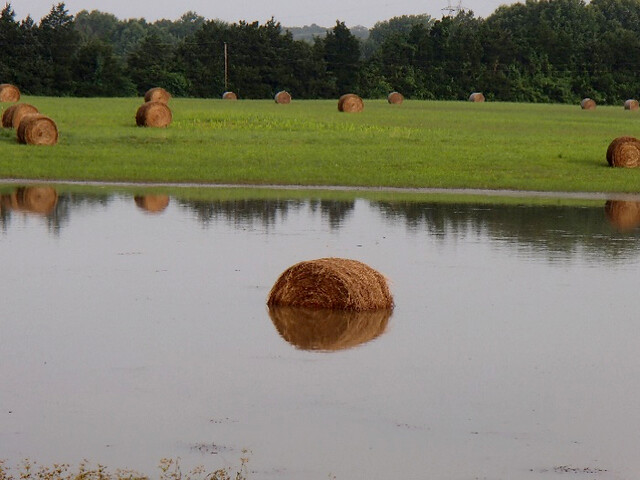Lessons from 2015: Pastures, hayfields can recover from flood
By Mary Hightower
U of A System Division of Agriculture
May 31, 2019
Fast facts
- Bermuda, bahia, dallis, fescue have brighter recovery outlook
- Find case studies: http://bit.ly/Ark-Forage-Recovery
(542 words)
(Download this story in MS Word format here.)
LITTLE ROCK – Research gathered following the flooding of 2015 will help Arkansans recover from damage to their pastures and hayfields by this year’s flooding, said John Jennings, professor-forage, for the University of Arkansas System Division of Agriculture.
“Pastures and hayfields are being severely damaged by record flooding along the Arkansas River,” he said. “The timing of this flood is similar to the flooding of April and May of 2015, although this year the water level and area damaged is much greater.
“Any standing forage will probably be ruined by this flood event, but information gathered during the 2015 and 2016 floods will help producers plan for recovery when flood waters recede,” he said.
Case histories are documented in the publication FSA 3145 – “Flood Damage and Recovery Management for Forages.” (See: http://bit.ly/Ark-Forage-Recovery)
Jennings said annual cool-season forages such as ryegrass and small grains will likely be killed by the flood due to the duration of the flood and the advanced maturity level of the grasses at the time of flooding, however the outlook is much better for bermudagrass, bahiagrass, dallisgrass and fescue.
“In 2015, bermudagrass survival was very good over most of the areas flooded by the Arkansas and Red Rivers,” he said. “In many cases bermudagrass fields recovered quickly after being inundated for 30-40 days.
“Tall fescue is not as resilient to flooding as bermudagrass, but its survival is much better than clovers and cool-season annual grasses,” Jennings said.
Other recovery issues
After the water recedes, producers will need to assess silt and sand deposits, as well as holes created by erosion, logs and other debris left in fields. Fast moving debris can snag and drag fence wire across pastures.
“Weed control and fertilization should be on the list of management practices to improve forage recovery,” Jennings said. “Weed seed can be transported for miles by flood water creating infestations in new areas. Topsoil may have been scoured away taking valuable nutrients with it, so additional fertilizer may help promote forage and root growth to re-establish forage stands.”
For more information on managing forage recovery after flood damage ask for FSA 3145 – “Flood Damage and Recovery Management for Forages” at your county extension office or go to http://bit.ly/Ark-Forage-Recovery.
About the Division of Agriculture
The University of Arkansas System Division of Agriculture’s mission is to strengthen agriculture, communities, and families by connecting trusted research to the adoption of best practices. Through the Agricultural Experiment Station and the Cooperative Extension Service, the Division of Agriculture conducts research and extension work within the nation’s historic land grant education system.
The Division of Agriculture is one of 20 entities within the University of Arkansas System. It has offices in all 75 counties in Arkansas and faculty on five system campuses.
Pursuant to 7 CFR § 15.3, the University of Arkansas System Division of Agriculture offers all its Extension and Research programs and services (including employment) without regard to race, color, sex, national origin, religion, age, disability, marital or veteran status, genetic information, sexual preference, pregnancy or any other legally protected status, and is an equal opportunity institution.
# # #
Media Contact: Mary Hightower
Dir. of Communication Services
U of A System Division of Agriculture
Cooperative Extension Service
(501) 671-2126
mhightower@uada.edu
